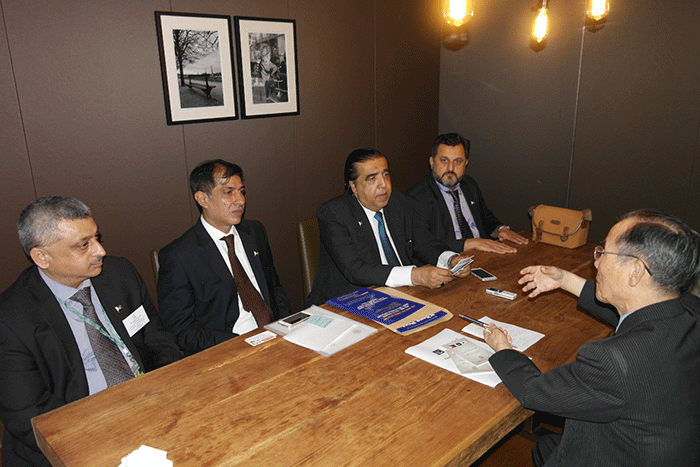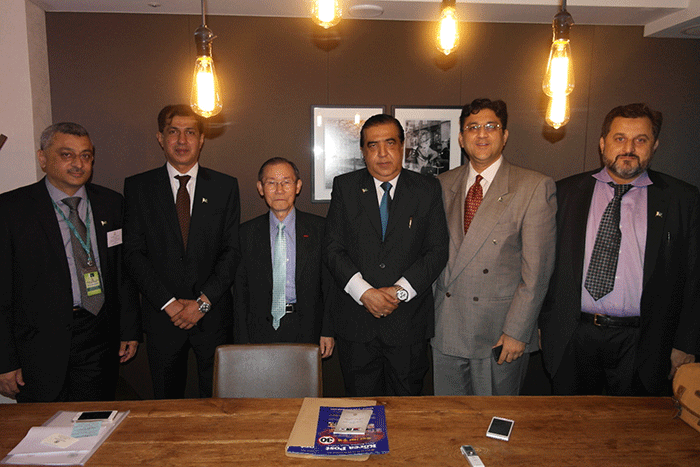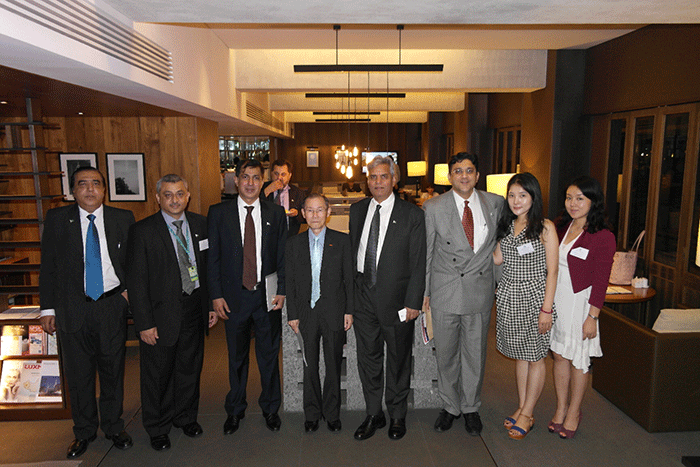Interview with President Usman of FPCCI
President Zakaria Usman of the Federation of Pakistan Chambers of Commerce and Industry (FPCCI) said that Pakistan has five major reasons for the Korean businesses to invest in Pakistan. He enumerated Pakistan has: (1) an irresistible geo-strategic location, (2) a lot of people (nearly 200 million) including very competitive labor, (3) a wonderful economic outlook, (4) attractive investment policies and (5) special economic zones, the temptations of which prospective Korean investors can hardly resist.
This was disclosed at an interview with President Usman conducted by Publisher-Chairman Lee Kyung-sik of The Korea Post at Seoul Palace Hotel on Aug. 26, 2014.

Usman came to Korea leading a business delegation of Pakistan, who included leaders of FPCCI such as Vice President Syed Mazhar Ali Nasir,Vice President Ismail Suttar and Chairman Sohail Nisar Churra of Pakistan-Korea Business Council of FPCCI(concurrently chairman of Sohail Industries). The meeting was arranged by Commercial Counsellor Aamir Nazir Gondal of the Pakistani Embassy in Seoul.
President Usman discussed a wide range of topics with The Korea Post on the economic and business cooperation between Korea and Pakistan with a special emphasis on the attractive conditions and climate in Pakistan for prospective Korean investors.
“Pakistan and Korea have great potential for increased trade and economic cooperation,” disclosed Usman, “but the two countries are yet to reach the level of cooperation in consideration of the potential they have.”
For one thing, Pakistan had nearly 200 million people, prospective consumers, and a vast competitive work force of young people?with an average monthly salary of semi-skilled workers ranging around only US$120.
Excerpts from the interview follow:
Attractive sectors for investment:-
Agriculture
Pakistan has a rich and vast natural resource base, covering various ecological and climatic zones; hence the country has great potential for producing all types of food commodities. Pakistan is agricultural super power in many ways but the yield is very low. There is 22.45 million hectares under cultivation area of which 16.5 million hectares is only in Punjab.

Power &energy
Pakistan is facing a severe power deficit since demand for electricity grew by 6-8% per annum in the past years without a commensurate addition in generation capacity. Power deficit estimated to cost the economy 2% of GDP per annum. Current power generation is heavily dependent on thermal power generation (approximately 70% of generation mix) and the focus is to encourage investments in indigenous resources to generation cheap electricity such as coal, nuclear, hydropower, solar and wind energy generation.
Mining&gems
Pakistan has excellent mineral potential including precious metals, dimension stones, industrial minerals, rock salt, coal, etc. but the potential has not been developed commensurately. Mismatch primarily due to capital intensive nature of investment. The mining and quarrying sector grew by 7.6% in 2012-13 as against 4.6 for the year before. 쌔 date, over 1,400 mining concessions have been granted and the sector contributes 2.4$ to GNP.
Infrastructure and construction
Government of Pakistan recognizes the importance of improving and expanding its infrastructure services for sustaining economic and social development. Improved quality and service coverage in power and water supply, sewerage treatment, transport and logistics are vital for Pakistan’s economy and the livelihood of its people.
The construction industry in Pakistan consumes 80% of national Development Budget. Fiscal constraints require innovative approaches ? away from the traditional mode of financing by the Government. Accordingly, the GOP has assigned top priority to developing low income housing under Private-Public partnership/Joint Venture. Public Private Partnership (PPP) is considered to be the way forward for development and delivery of infrastructure leveraging private sector financing and expertise. The construction industry had a total value of approx. USD 3.78 billion in 2012 and this value is expected to rise to around USD 10.4 billion by 2020.
IT & Telecom
Pakistan’s telecommunications industry holds tremendous potential for growth, investment and development. Currently, Pakistan is one of the fastest growing telecommunications market and since 2005; an FDI of approximately $5.7 billion (net) has been received in Pakistan’s telecom sector. The sector contributes 3% contribution to GDP and is equipped with strong human resource base, which is well-trained and educated. The sector has more than;
Textile
Pakistan is the 8th largest exporter of textile products in Asia. This sector contributes 8.5% to the GDP and provides employment to 40% of industrial labor force. Pakistan is the 4th largest producer of cotton with the third largest spinning capacity. Export of cotton denim fabrics from Pakistan increased from 263 million sq. meters worth Rs 26.77 billion in 2010-11 to 320 million sq. meters worth Rs. 35.34 billion in 2011-12, thus showing an increase of 32% in terms of value. The major markets during 2011-12 were Bangladesh, Turkey, Egypt, and Colombia
For Pakistan which was one of the leading producers of cotton in the world, the development of a textile Industry making full use of its abundant resources of cotton has been a priority area towards industrialization. At present, there are 1,221 ginning units, 442 spinning units, 124 large spinning units and 425 small units which produce textile products.
The sector consumes 40% of banking credit to manufacturing sector and drives shipping, transport, insurance, machinery, dyes/chemicals, printing, packing and allied sectors as well.

Retail sector
The Pakistani retails industry is one of the least concentrated in the world as there are few major chains, low rates of car ownerships, home registration, purchasing power and relatively small number of modern retail formats mean the most Pakistanis shop daily at small neighborhood mom-and-pop specialty shops. They are spread across the length and breadth of the country. Indeed the numbers of traditional mom-and-pop stores have mushroomed in recent years. Pakistan is showing up more brightly on the radar screens of major retailers, largely due to massive and growing population of roughly 170 million people. Although, the country is developing, it experienced strong economic growth in period 2004 ? 2007 thereby boosting consumer spending power. In addition, street markets, roadside vendors and hawkers operate in all major cities and villages across Pakistan. In many rural areas, this informal sector forms an important retail channel and holds a critical position owing to their access to fresh produce.
Supermarkets remain in their infancy in Pakistan and few supermarkets operation is even limited to country’s commercial capital, Karachi and Lahore.
Automotive
Pakistan possesses huge potential to become a manufacturing and exporting hub of the auto industry for renowned original equipment manufacturers (OEMs) of the world. By 2013, there were 3,200, there were 3,200 units of automotive industry with the investment of Rs 92 billion, employing 3.5 million people and producing annually 1.8 million motorcycles and 200,000 vehicles. The sector contributes 3% to the GDP. Vehicle Sales correlated with interest rate regime, especially for small-low and economy segments, whilst purchases in small-high (1300 CC and above) correlated with rising income level. The sector recorded significant positive growth of 17% during financial year 2012-2013. The auto-part Industry is generating exports of Rs 128 million.
The support of local automobile companies and the auto-part vendors has attained excellence in some filed at par with the global standard but there is a room for further development for vendors to scale up their production with the cutting edge technology and emerging trends in the international automobile market.
Financial Services
Banking system of Pakistan comprises of 38 Commercial Banks, 10 Microfinance Banks and 8 Development Finance Institutions. The banks/DFIs are operating with a network of 11,911 branches across the country. Pakistani banks have international presence in 36 countries around the globe, in almost all regional territories with 106 branches, 9 subsidiaries and 15 Representative Offices.
The financial system of the country is dominated by banking sector with private banks holding around 78% of the total assets of the banking system. Public sector banks and foreign banks hold 20% and 2% share in total assets respectively. The balance sheet of the banking sector has increased to Rs. 9.9 trillion and its financial position is as under:
Tourism
Pakistan has a blend of beauty and historic sites, ranging from the peaks of Karakorum to the historic civilization of Mohenjo-Daro. Tourism development can be a massive source of earning for Pakistan as it possesses top-class tourist attractions from the stunning Himalayan peaks, beautiful lakes, scenic valleys, rich culture, centuries-old civilizations, vast deserts, golden beaches of Makran to all the other natural and man-made attractions. In addition to this, the country has a long water coast of the Arabian Sea in the southern region.
Tourism services such as airlines, hotels, resorts, road transportation provide unique business avenues to investors in the diversified geographical region of Pakistan.

Pharmaceutical
Pakistan’s pharmaceutical industry has the potential to propel the country to a much needed economic prosperity estimated at $5 billion plus in a span of five years. Presently, however, Pakistan has negligible presence in the global pharmaceutical industry of almost $1 trillion that is expected to grow to $1.1 trillion by 2014. Pakistan’s pharmaceutical industry stands at a little over @2.1 billion with exports of roughly $190. The cumulative annual growth rate of pharmaceutical industry has been 12% during the last three years and local companies launched 2,956 products from 2008 to 2012 as compared to just 193 products by multinational companies.
Due to low population penetration rate of the healthcare, sales do not show seasonality and remain flat, generally. Total pharmaceutical market is valued at $1.6 billion of which 53% share is held by local companies. Major international players in Pakistan are GlaxoSmithKline Pakistan, Johnson & Johnson, Aventis Ltd, Abbot, Novartis, and Pfizer etc.
Investment Growth Potential
Due to rising life expectancy, spending in healthcare is expected to rise in the coming years and forecasts predict Pakistan to be 11th largest pharmaceutical market globally by 2016.
Parma industry export size currently stands at around $100 million and has the potential of crossing $1000 million mark.

